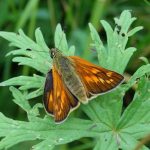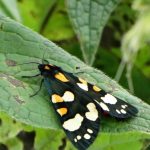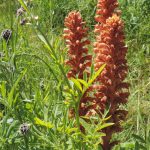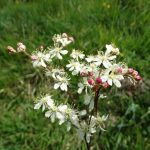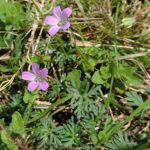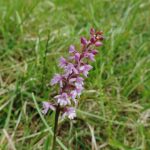Rob Stallard led a circular walk which started from BBOWT’s Seven Barrows Reserve near Lambourn on Wednesday 20 June. The route started out up the road towards Crog Hill. On the verge at the side of the road were Dropwort and three yellow members of the Daisy family – Rough Hawk’s-beard, Mouse-ear-hawkweed and Rough Hawkbit. Rob told the group that long barrows belong to the oldest surviving architectural tradition in England and that the Crog Hill barrow is one of the earliest, thought to date back to about 3700BC. Beech trees grow around the barrow site. On the other side of the track was a White Helleborine which had gone to seed, together with a number of Pyramidal Orchids and Common Spotted-orchids. The track continued westwards along the county boundary between West Berkshire and Oxfordshire. Sightings along this stretch included Horseshoe and Kidney Vetch, Greater Knapweed, Fairy Flax, Goat’s-beard, Meadow Crane’s-bill, Common Broomrape and Field Scabious. The commonest butterfly was Meadow Brown, but Common Blue, Small Blue, Small Heath and a single very fresh Marbled White were also seen here. The route then turned southwards, along a track which ran beside racehorse gallops. Kidney Vetch and Fairy Flax were particularly abundant here, together with Large Skipper butterflies and Narrow-bordered Five-spot Burnet moths. Yellowhammers and Corn Buntings sang from the top of scattered Hawthorn Bushes. The track passed into a less open section, where Bramble, Dog-rose and Privet were in flower. Speckled Wood and new generation Brimstone butterflies were seen here and a herd of nine Fallow Deer was disturbed. The route continued past Hangman’s Stone, then turned sharply back north-eastwards onto another track. There were several big patches of Comfrey here which were being visited by bees and a Scarlet Tiger moth. 23 tall brown Knapweed Broomrape plants were counted along this section of the track. Ringlet and Small Tortoiseshell butterflies were seen as the track approached the road. The final part of the walk was spent on the Seven Barrows reserve. The reserve had become very overgrown. To correct this, it had been heavily grazed by cattle earlier in the year. Sightings here included Chalk Fragrant-orchid, Long-stalked Crane’s-bill, Saw-wort, Common Rock-rose, Wild Thyme, Squinancywort, Hoary Plantain, Dropwort, Quaking-grass, Lady’s Bedstraw, Bladder Campion, Common Bird’s-foot-trefoil and Horseshoe Vetch and five Ravens flew calling nearby. The walk was followed by lunch at the George Hotel in Lambourn, where screaming Swifts were flying overhead.
Pictures by Rob Stallard and Laurie Haseler

